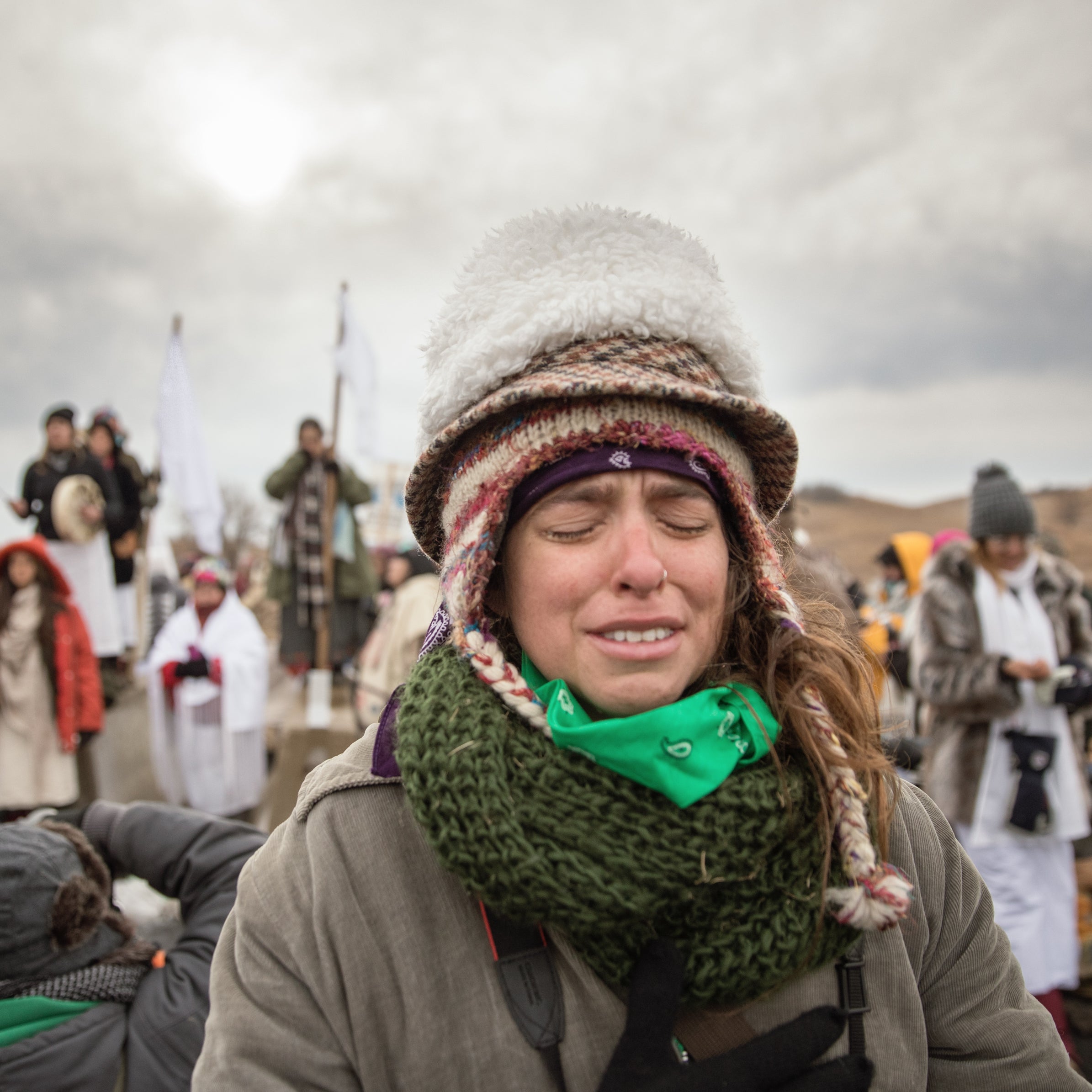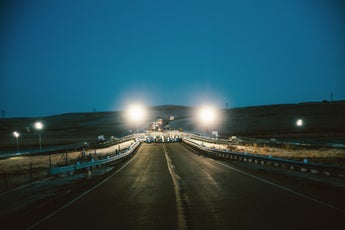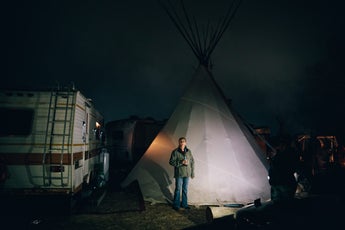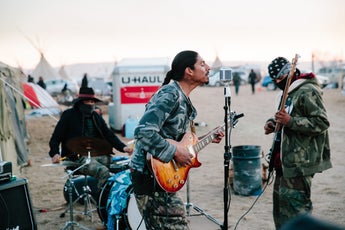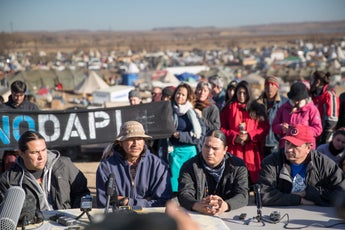All around camp, the sounds of the resistance were in full swing. Chainsaws to cut firewood and power tools in the service of simple wooden structures. Trash pickers crawled through the dumpsters in search of plastic water bottles and other synthetics that can be used as insulation. Winter was coming to the Oceti Sakowin camp on the banks of the Missouri River’s impounded Lake Oahe. Native Americans and the loose coalition of their supporters (or allies, as they prefer to be called) opposed to the Dakota Access Pipeline have two antagonists: the authorities and the elements. This was the weekend of November 26, Thanksgiving weekend, and it was the last T-shirt weather of the year.
My girlfriend, Emma, and our friend Beau, from Santa Barbara, spent the Thanksgiving holiday in Standing Rock. Our sub-camp was organized by the Lower Brule Sioux out of central South Dakota and home to Rachel’s Kitchen, one of the main army mess tents which collectively feed the entire camp. At the moment it was running low on water and firewood but nobody seemed to know where to get more. Like a microcosm of the overall camp, it had little in the way of organizational structure, and things instead got done based on who was willing to step up and take charge and who was willing to lend a hand.
In that way, the protest is also a giant experiment in group dynamics, multi-culturalism, and, for many, a crash course in winter camping. In order to put up a fight, the protesters first need to survive in a climate where the average daily low temperature is 2 degrees Fahrenheit. The record low in Bismarck is minus��45.
All of this the tribes are doing with the hope that the pipeline is still sitting incomplete on January 1. That’s the deadline Energy Transfer Partners set with investors to start pumping crude from the Bakken oil fields. ��“If it misses this deadline,” according to from the left-leaning Institute for Energy Economics and Financial Analysis, “companies that have committed long-term to ship oil through the pipeline at 2014 prices have the right to rescind those commitments—and may well exercise that right.” That’s because oil prices are lower now than they were in 2014, which protesters hope will put��the project on shaky financial footing even before you consider the political fallout.
If you’ve been following the news out of Standing Rock, you may have noticed a thread of stories about how people need to stop treating the protest like Burning Man and that white people are showing disrespect by turning up at camp hoping for a “cultural experience.” I saw plenty of evidence of the Burning Man crowd in Standing Rock, along with Bernie supporters, ��Black Lives Matter activists, and an otherwise loose assemblage of America’s once and future marginalia. A British cross-country cyclist named Andy (a.k.a. “The Hobbit”) had been following the Lewis and Clark trail when he stopped in Standing Rock for the winter and built himself a well-insulated fort entirely salvaged from the camp’s dumpsters. But if there was freeloading, ��infighting, or disrespect, I never saw it. Nor did I see anybody using drugs or alcohol, which are explicitly banned from camp. Instead, the protest has evolved into a prayer camp with an emphasis on silent prayer and native-led ceremonies.��
In general, the camp had the feel of an all-hands-on-deck operation where people were nicer and more helpful to each other than you would see in the world at large. If you were trying to load or unload firewood, there would immediately be a dozen people there to help get the job done. Maybe there’s something about having a common purpose. There was singing every night—either traditional or protest rock and rap affairs on the north end of camp next to the screen printing tent that could barely keep up with the demand for T-shirts and patches with slogans like Mni Wiconi—Water Is Life! There was a benefit concert at the Prairie Nights Casino ten miles south of camp on the way to Fort Yates where Jackson Browne, Bonnie Raitt, and Jason Mraz played. Taboo from the Black Eyed Peas made to look like the camp. And for Thanksgiving, the actress and activist Jane Fonda held a dinner at the high school in Fort Yates for 1,400 people.
The Lower Brule camp turned out to be full of Burning Man types, which you might interpret as an affirmation of the recent criticism. Except for one thing: they’re good at camping, raising money, and executing group projects. How else do you think those insane art installations in the desert get made?
A woman named Pilar and her boyfriend Ron, a DJ from the Bay Area, leaned on their friends to come up with money for firewood. “My friends kept posting, asking, ‘What do they need?’” They raised $3,500 and had three dump trucks deliver 28 cords of wood to the camp. Rachel, the kitchen’s founder, needed a break and Ron, who’d worked in commercial kitchens, reorganized the entire thing to run like an efficient buffet. Hal, a veteran and longtime Burner, became the head cook. Our friend Beau, a carpenter who runs a successful xeriscaping business in Santa Barbara, organized a work crew that built a new lean-to shelter at the main camp fire, where announcements are made every morning. Saba, who’d recently started a successful biodegradable glitter company, taught at the makeshift school that had been set up in camp.
All of this was being done with the goal of making the camp harder to be swept away, either by government troops or the icy winds. The Sioux method of camping avoids digging into the land. Teepees are set on the ground, not dug in. To prepare for the snow, hay bales are ringed around the edges to function as a skirt. In previous generations, they would have had buffalo hides to drape over their teepees as insulation, but many of the modern iterations are made from canvas or even plastic, in which case it's��. ��
But in camp, that no-trace ethic has been bent to allow for insulated wooden structures—which require posts to be dug into the ground. Still, the camp itself is on a floodplain of the Cannonball River, and the Army Corps of Engineers controls the level of the lake. Come spring, the whole thing could literally be swept away. In a November 26 press conference, tribal chairman David Archambault II acknowledged that the Oceti Sakowin camp—which is now it’s own location on Google maps, complete with an average of five-star reviews—is in a precarious position and that steps are being taken to create other housing for activists elsewhere on reservation land.
That press conference had been called in response to the Army Corps of Engineers’ notice of camp wide eviction set for December 5. Archambault noted that the eviction wasn’t predictive of a camp raid, only an attempt to place legal responsibility for the camp, which sits on Army Corps of Engineers Land, onto the tribe.
A group of more than a thousand military veterans were still to hold their own protest against the pipeline. And direct actions, including a silent prayer circle and women’s march to the bridge on Highway 1806, would still take place.
��
We stayed through Sunday evening, when a group of elders defied the police barricade and performed a water ceremony near the blockaded bridge. The authorities, it seemed, had been chastened by the bad press they’d received for the Bull Connor firehose routine the previous Sunday and were on their best behavior. Protesters tested them by buzzing their positions with small quadcopter drones, daring the authorities to shotgun them out of the sky. (At a gathering the previous day, the drones drew ire from within the protesters’ own ranks for the nuisance during what was supposed to be a silent prayer.)
It’s impossible to spend time in a protest camp like the one on the banks of the Cannonball River and not feel some sense of empathy for a portion of the population that has been marginalized more than any other. But more than that, people have latched onto #NODAPL because it wraps up so many environmental and social issues ��into a highly photogenic package. America’s military-industrial fossil fuel past is on one side of a razor wire fence and its multi-ethnic environmental future is on the other. Or maybe our past will actually be the future.
With President Trump being sworn in on ��January 20, Standing Rock will likely become an example for how the new administration deals with dissent. It may even be possible that the more militant wing of the environmental movement will take shape in Standing Rock. (After all, Earth First was founded on April 1, 1980, only three months after Reagan took office.)
As we left camp, cold rain was falling. By midnight the rain had turned into sideways snow and North Dakota governor Jack Dalrymple was calling for a weather-related evacuation of the camp. But nobody moved. The firewood had all been cut and stacked under canopies. People piled together in tents and teepees and old travel trailers. The North Dakota winter has arrived, but the camp appears to be weathering it.


